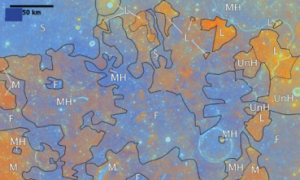
Abstract:Marius Hills is a volcanic plateau on the nearside of the Moon. It is of great interest for its high concentration of volcanic features, including domes, cones, ridges, and rilles. However, the morphological and chronological characteristics of this plateau were not well studied due to the low resolution of early mission data. This study describes the detailed morphology of the volcanic features using the latest high spatial resolution images of the Terrain Camera (TC) onboard Selene-1 (10 m/pix) and Narrow Angle Camera (NAC) onboard the Lunar Reconnaissance Orbiter (LRO) (0.5 m/pix). We report here some new structures such as skylights and remnants of lava tubes. We have divided spectrally homogenous areas with Clementine UVVIS data and did crater size frequency distribution (CSFD) measurements with Lunar Orbiter (LO) IV and TC images in every spectral unit. We first report absolute model ages of 1.10 Ga for Marius basalt 1, 1.49 Ga for Flamsteed basalt, and 1.46 Ga for Schiaparelli Basalt. In addition, we have identified several younger lava events: they are Marius basalt 2 (814 Ma), medium to low titanium basalt (949 Ma), and undifferentiated medium titanium basalt (687 Ma). Finally, we propose a mantle plume scenario for the formation of Marius Hills, which could solve the inconsistency of previous models.
